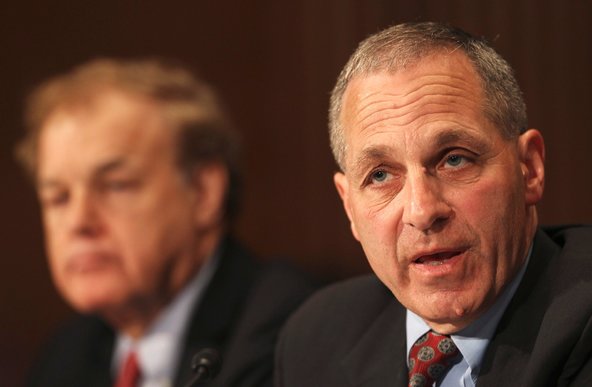Given the onslaught of lobbying against Ms. Schapiro’s efforts, it is perhaps not surprising that Ms. White’s proposal is much more incremental than her predecessor’s.
Money market funds need tighter regulation because both individual and institutional investors rely on them as bank-account alternatives. These investors have come to believe that their holdings will never decline in value; $1 in will always be $1 available for redemption. But unlike banks, money funds do not have to set aside capital for either redemptions or losses. Therefore, money funds can be vulnerable to runs when shareholders stampede for the exits.
This is what happened after Lehman Brothers failed in 2008. The Reserve Fund, an enormous, institutionally held money fund that owned some of the brokerage firm’s debt, had to halt redemptions in an investor run. Recognizing that the potential for problems wasn’t limited to that fund, the federal government offered insurance to money funds during the crisis.
To prevent a future run on these funds, the new, nearly 700-page S.E.C. proposal offers two possible regulatory fixes. One would require some funds to abandon the fixed $1-a-share asset price and require the price to float, based on fluctuations in their holdings.
The idea here is to dispel the myth that each share of a money fund is worth precisely $1 at the end of every business day. That fiction has lulled investors into complacency about the funds’ safety and predictability.
But only prime institutional funds — which account for almost 40 percent of the overall market — would have to show floating net asset values under the rule. Money funds that invest mostly in government securities and those aimed at individual investors would be exempt. The S.E.C. said this was because government portfolios and retail funds hadn’t run into redemption problems.
The S.E.C.’s proposal “targets precisely the funds that ran the most in 2008,” said Norm Champ, director of the S.E.C. division of investment management, in an interview. “The S.E.C.’s staff economic study showed that institutional investors redeemed from money market funds at a much higher rate than retail investors during the 2008 financial crisis.”
It’s likely, though, that the panic would have spread to retail funds if the government hadn’t stepped in with its insurance program.
The proposal offers another attempt to prevent a run: a redemption charge. If any fund’s so-called weekly liquid investments fell below 15 percent of its total assets, the fund could impose a 2 percent fee on all redemptions. (Weekly liquid assets are typically cash, United States Treasury securities and instruments that convert into cash within seven days.) Once a fund crossed the 15 percent threshold, its overseers could also halt redemptions for as long as a month, allowing an orderly sale of assets as well as time for panicked investors to cool down.
The fund industry may not like some of this, but it is sure to be delighted about what is absent from the S.E.C.’s proposal. Unlike last year’s version, this one does not require money market funds to set aside capital to protect against mass redemptions.
Setting aside capital is the best way to protect shareholders from funds that take excessive risks, as well as from the perils of a panic, says David S. Scharfstein, a professor of finance and banking at Harvard Business School and an expert on money funds.
“The run doesn’t just come from a fixed net asset value,” he said in an interview last week. “It comes from the underlying assets that are illiquid.” He prefers a capital requirement of between 3 and 4 percent.
The industry, which sees required capital set-asides as anathema because they crimp profits, would have fought such a provision as fiercely as it did the last time. The S.E.C. may have found it preferable to propose a rule that was workable, not dead on arrival.
Another criticism of the rule, Mr. Scharfstein said, is that while it purports to provide investors with a true market value for a fund’s holdings, it offers significant leeway in determining those valuations. It would not require funds to assign prices based on market transactions on securities that come due in 60 days or less. The fund could value those at the cost it paid to buy them, so long as the fund’s directors thought that the prices represented fair value.
But those valuations may not reflect what a fund would really receive in a sale. “Most money market fund assets mature in less than 60 days,” Mr. Scharfstein said. “This could allow them not to mark to market a fairly large fraction of their portfolios.”
The greatest strength of the S.E.C.’s proposed rule is that it would require greater transparency, bringing money funds out of the Dark Ages where disclosures are concerned. It would require funds to divulge material matters, such as when the 15 percent threshold is crossed for liquid assets or a relatively large holding goes into default. And what if a fund gets into trouble and requires the financial support of its parent? Investors would be told.
Finally, under the rule, the funds would have to report their holdings within five days of each month’s end, rather than the two months they can wait now.
“The proposal would require funds to disclose information that investors have never had access to before,” Mr. Champ said. “It will be a major step to increasing investor knowledge and understanding of the product.”
Now that the rule has been proposed, the S.E.C. will field comments for 90 days.
Could the rule be stiffened? Probably not by the S.E.C. Dennis Kelleher, president of Better Markets Inc., a nonprofit advocating effective financial regulation, said regulatory proposals usually weren’t expanded beyond their initial outlines.
But, he said, there is a possibility that the Financial Stability Oversight Council, the regulatory group created under the Dodd-Frank law, may toughen the rule. In November, after the S.E.C. failed to come up with an acceptable proposal, the stability council suggested three money fund reforms. They went beyond the S.E.C.’s rule, proposing either a floating net asset value for all money funds, or capital buffers.
“The F.S.O.C. has the power and authority it needs to address systemic risks,” Mr. Kelleher said. “If the final rule is weak and deficient and leaves a significant systemic risk to the financial system unaddressed, they have the duty to act under the law.”
Whether they will is another issue. Clearly, the battle for safer money funds is far from over.

Article source: http://www.nytimes.com/2013/06/09/business/sec-plan-for-money-market-funds-takes-some-baby-steps.html?partner=rss&emc=rss


